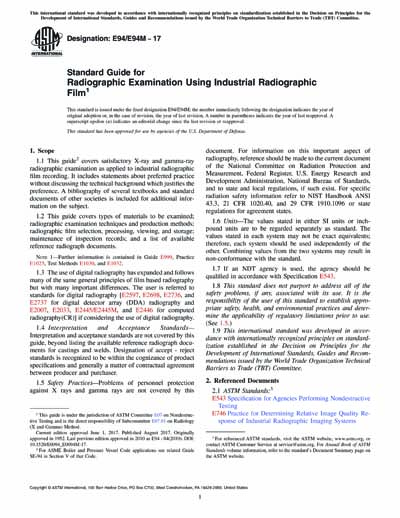Historical
ASTM E94/E94M-17
Standard Guide for Radiographic Examination Using Industrial Radiographic Film
1.1 This guide2 covers satisfactory X-ray and gamma-ray radiographic examination as applied to industrial radiographic film recording. It includes statements about preferred practice without discussing the technical background which justifies the preference. A bibliography of several textbooks and standard documents of other societies is included for additional information on the subject.
1.2 This guide covers types of materials to be examined; radiographic examination techniques and production methods; radiographic film selection, processing, viewing, and storage; maintenance of inspection records; and a list of available reference radiograph documents.
1.3 The use of digital radiography has expanded and follows many of the same general principles of film based radiography but with many important differences. The user is referred to standards for digital radiography [E2597, E2698, E2736, and E2737 for digital detector array (DDA) radiography and E2007, E2033, E2445/E2445M, and E2446 for computed radiography(CR)] if considering the use of digital radiography.
1.4 Interpretation and Acceptance Standards—Interpretation and acceptance standards are not covered by this guide, beyond listing the available reference radiograph documents for castings and welds. Designation of accept - reject standards is recognized to be within the cognizance of product specifications and generally a matter of contractual agreement between producer and purchaser.
1.5 Safety Practices—Problems of personnel protection against X rays and gamma rays are not covered by this document. For information on this important aspect of radiography, reference should be made to the current document of the National Committee on Radiation Protection and Measurement, Federal Register, U.S. Energy Research and Development Administration, National Bureau of Standards, and to state and local regulations, if such exist. For specific radiation safety information refer to NIST Handbook ANSI 43.3, 21 CFR 1020.40, and 29 CFR 1910.1096 or state regulations for agreement states.
1.6 Units—The values stated in either SI units or inch-pound units are to be regarded separately as standard. The values stated in each system may not be exact equivalents; therefore, each system should be used independently of the other. Combining values from the two systems may result in non-conformance with the standard.
1.7 If an NDT agency is used, the agency should be qualified in accordance with Specification E543.
1.8 This standard does not purport to address all of the safety problems, if any, associated with its use. It is the responsibility of the user of this standard to establish appropriate safety and health practices and determine the applicability of regulatory limitations prior to use. (See 1.5.)
1.9 This international standard was developed in accordance with internationally recognized principles on standardization established in the Decision on Principles for the Development of International Standards, Guides and Recommendations issued by the World Trade Organization Technical Barriers to Trade (TBT) Committee.
Content Provider
ASTM International [astm]






